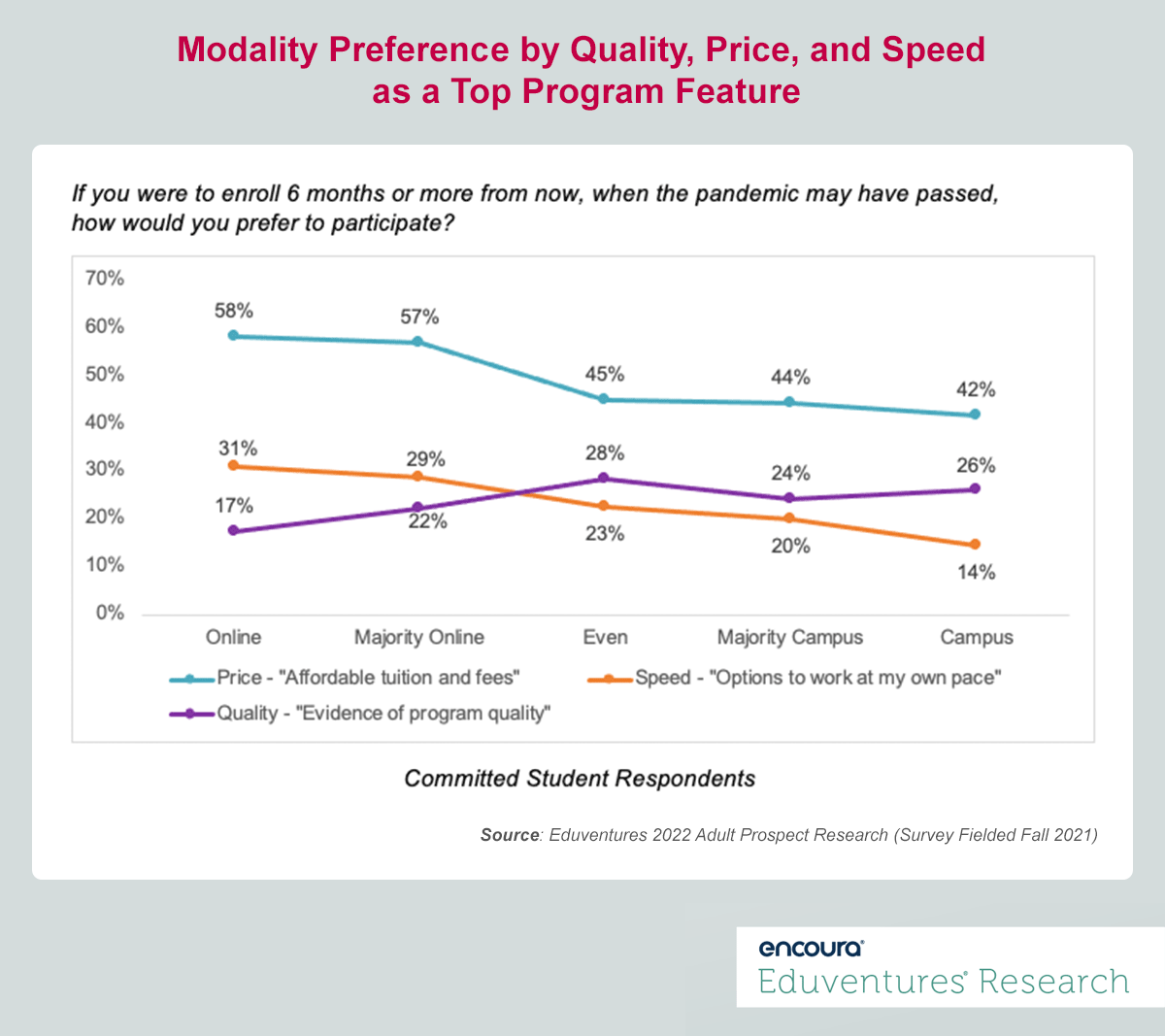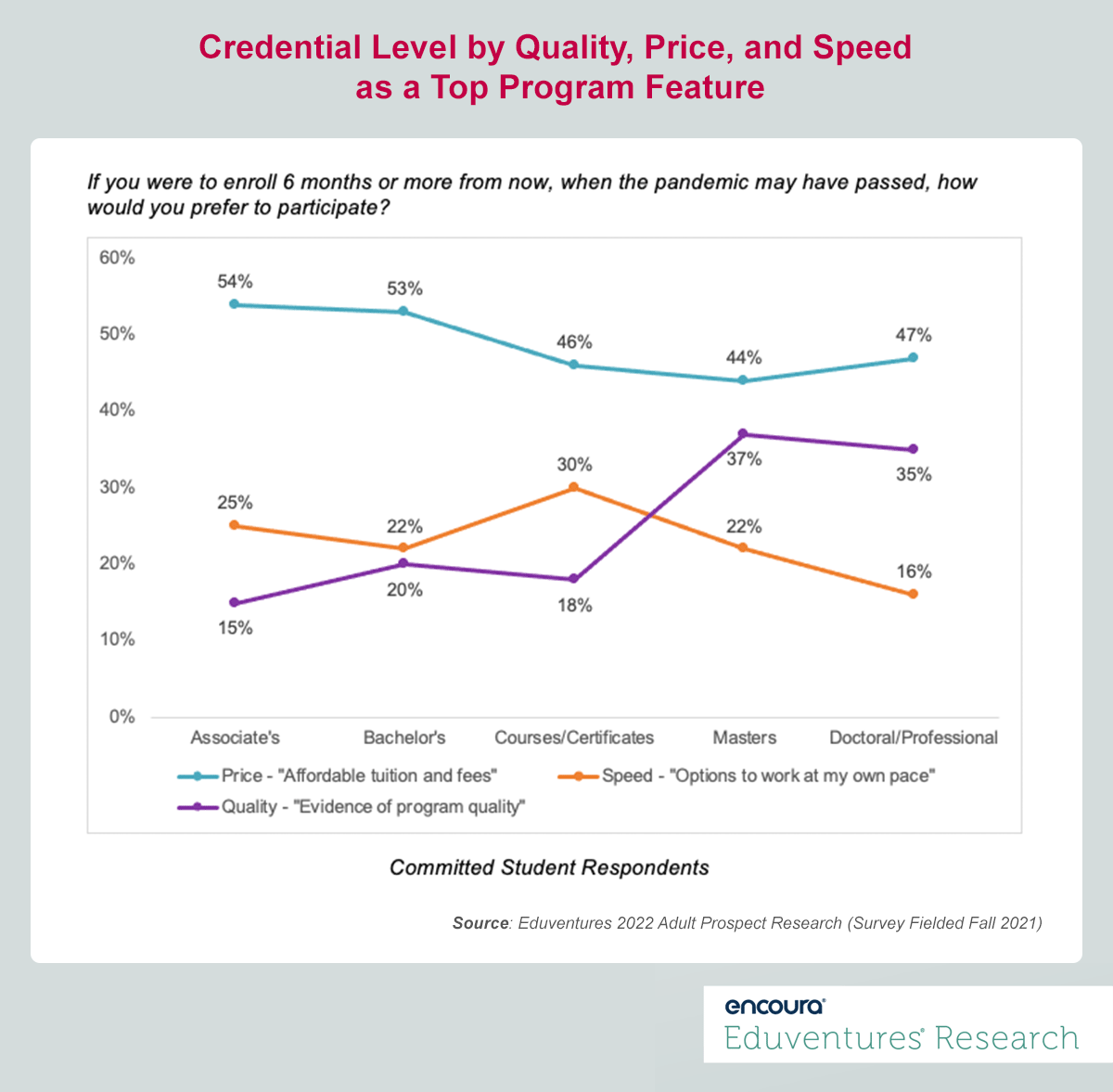A recent study by New America reported that 55% of respondents said online learning was as good as or better than in-person instruction, up from 37% a year ago. At the same time, 80% of respondents believed that online instruction should be less expensive than in-person instruction, consistent with the prior year.
The old saying goes, “Quality, price, and speed: you can pick only two.” Historically, most online programs have opted for low price and high speed—the unspoken assumption that quality is the trade-off. But, by many measures, the pandemic has complicated previously held notions about online learning and student expectations.
Quality, Price, and Speed Preferences
Our 2023 Adult Prospect Research™, currently in the field, will of course give us the most up to date read on this question. But marrying our mid-late pandemic data with known trends in online learning allows us to make some informed predictions.
When determining the relevance of the quality, price, and speed paradigm, it is first important to note that these three features communicate different values. Price and speed are innately quantitative. Quality, on the other hand, is subjective, often equating to rankings and reputation, faculty interaction, or student outcomes, to name a few.
Even with these quality markers, however, there remains an underlying assumption, as seen in the New America survey, that getting the “digital” version should be less expensive. But institutions have strategically promoted online and campus programs at the same price to signal they are the same quality. Following this paradigm, a program should demonstrate quality and speed to make up for price.
Our Adult Prospect Research indicates that students value the program features of quality, price, and speed differently based on their modality preferences. For example, "committed students,” those respondents who have indicated they are likely to enroll in a program, overwhelmingly chose price, or “affordable tuition and fees,” as the top program feature (Figure 1).
Figure 1
Figure 1, however, shows that students who preferred more in-person instruction value program quality more than students who preferred online instruction. This follows the post-pandemic message that expectations have shifted to a more hybrid approach. According to one chief online officer who participated in the CHLOE 7 survey, “Students increasingly expect in-person, hybrid, and online to be all leveraged where appropriate to provide them quality experiences and flexibility in rapidly completing a degree.”
Campus availability is one aspect, but students who preferred online instruction value speed more than quality. Online students also preferred price more than campus-focused students, which aligns with New America’s findings that online instruction should be less expensive.
While Figure 1 combines “committed students” across all credential levels, Figure 2 (below) analyzes program preferences based on credential type. Our data shows that preferences for price, quality, and speed also vary based on credential level, regardless of modality.
Figure 2
Here again, students at all program levels chose price as the top feature, ranging from 44% to 54% depending on credential level. But students interested in an associate or bachelor’s degree, and those interested in courses/certificates, chose quality less often than graduate students—ranking lowest among the three options.
What can explain this difference between program levels and quality preference? It’s safe to conclude that students who have earned at least a bachelor’s degree understand the cache—or lack thereof—that their current degree affords them and would be more sensitive to quality when seeking a graduate credential.
Some institutions are rethinking program design and promotion based on these core program features.
Institutions Breaking from the Pack
While many institutions commonly look to offer lower prices or “accelerated” programs to compete in today’s online marketplace, others are looking to reset the paradigm for online student preference. The following examples show how institutions can navigate the trade-offs between quality, price, and speed.
Quality + Speed: USC Keck School of Medicine
University of Southern California’s (USC) Keck School of Medicine, a highly ranked Medical School by U.S. News & World Report, offers “the only online MPH (Master of Public Health) by a top-ranked medical school with world-renowned faculty.” Like many schools, USC has a record of matching the prices of its online and campus-based programs to signal quality. It offers an Accelerated MPH Fast-Track option that can be completed in just four semesters, compared to six or seven, typically. With such an intense program, it does not recommend students work while doing this program. The program is priced at nearly $90,000—a sign it is leaning in on quality and speed.
Quality + Price: Georgia Tech Online
Arguably one of the most successful online programs from a nationally ranked institution is the Georgia Tech Online Master of Science in Computer Science (OMSCS) launched with support from AT&T in 2014. Per the program website, over 10,000 students have enrolled as of Fall 2020 – in just that one program. If the OMSCS program was an institution, it would have been the 20th largest by total graduate online enrollment. An Inside Higher Ed article described it as “Online, Cheap – and Elite,” with a total price of less than $7,000. Although this program has disrupted the market, the program typically takes three years to complete, indicating that it has prioritized price and quality.
These examples illustrate how respected institutions are thinking about the quality/speed/price paradigm differently and are maximizing quality for their online programs. They also illustrate that when prioritizing quality, the paradigm still holds true: you can only pick two. Students would certainly prefer high quality, low price, and high speed, but that breaks the paradigm. The third option, of course, is low quality, low price, and high speed – the bane of online programming.
The Bottom Line
While price remains the top program feature across modalities and degree levels, graduate students and those who prefer a hybrid or campus-based experience value evidence of program quality more than others. Fully online students and those seeking undergraduate degrees value speed more than quality. Even among these trends, it’s important to recognize that these students are not homogenous but value different features.
Most programs, however, have taken a homogenous approach by promoting cheaper and faster online programs, which will ultimately be a race to the bottom. We predict that the post-pandemic pivot in online education will be to focus on quality.
While programs typically signal quality by relying on their rankings, reputations, and accreditations, institutions without national rankings will need to accentuate their identity and strengths so they can distinguish themselves. Markers of quality can also include new innovative pedagogy, a hybrid/regional approach, clearly linking programs to career outcomes, or highlighting a passionate faculty and student community.
Moving toward a focus on quality can make a program stand out in the ever-growing and competitive online program market, while also justifying the price.
Never Miss Your Wake-Up Call
Learn more about our team of expert research analysts here.
Eduventures Senior Analyst at Encoura
Contact
The higher education market has reached a level of maturity that requires a more sustainable approach toward academic programming. Because the stakes are higher than ever, Eduventures has moved beyond the conventional standards of program feasibility to focus on the end goal – the overall success of your institution and its students.



